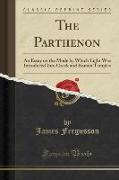- Start
- The Parthenon
The Parthenon
Angebote / Angebote:
Excerpt from The Parthenon: An Essay on the Mode by Which Light Was Introduced Into Greek and Roman Temples
The only architect of eminence who subsequently has adopted De Quincy's proposal Of a circular roof to Greek temples is Edward F alkener. In his 'daedalus'2 he adopted a semicircular roof for the Parthenon, employing in its defence the same arguments that were used by De Quincy, but adopting them mainly because, except by means of a vault, he fancied he could not find room for the colossal height of the statue of Minerva as described by Pliny.3 This however is a difficulty entirely of his own raising. He assumes that the 26 cubits of Pliny apply only to the statue of the goddess, exclusive of the pedestal on which She stands, while the description, taken as a whole, seems to imply that Pliny included the pedestal with its sculptures as part of the group, and that his measurement of height was taken from the ¿oor line. But even if this were not so there are other means, without resorting to the extreme expedient of vaulting, by which the statue, with a moderate pedestal, could be accommodated under a properly designed roof. But of this hereafter. Meanwhile it is curious to observe how much our knowledge of the details of Greek architecture has progressed during the half-century that has elapsed between the publication of these two works. Instead of the weak mean vault of De Quincy we have one of great architectural beauty and strength, but this only serves to bring out more forcibly the defects of the system. To leave an opening in the eye of a dome is mechanically correct. It relieves the vault of weight, where weight is injurious to stability, and, with a circular rim round it, its form is constructively correct in every respect. But on the other hand to cut a square opening in a waggon vault - to remove the keystone in fact - is an architectural solecism which we may feel sure the sense of architectural propriety in a Greek would never have tolerated in any vault, either in stone or wood. Besides this, the wandering light from a naked Skylight would have been most inartistic and disagreeable, not only because of the glaring sun that must have shone on the worshippers at mid-day, but of the rain and snow against which, on this system, it was impossible to provide any protection. Everything, in fact, combined to render this mode of lighting the temple most objectionable, while the gain in height was insignificant. In the section, Plate III. Of this work, the thickness from the summit outside to the under side of the beam is 7 feet. In Mr. Falkener's section (page 18) it is 5 feet, with difficulties of construction which seem almost insuperable.
About the Publisher
Forgotten Books publishes hundreds of thousands of rare and classic books. Find more at www.forgottenbooks.com
This book is a reproduction of an important historical work. Forgotten Books uses state-of-the-art technology to digitally reconstruct the work, preserving the original format whilst repairing imperfections present in the aged copy. In rare cases, an imperfection in the original, such as a blemish or missing page, may be replicated in our edition. We do, however, repair the vast majority of imperfections successfully, any imperfections that remain are intentionally left to preserve the state of such historical works.
Folgt in ca. 5 Arbeitstagen
